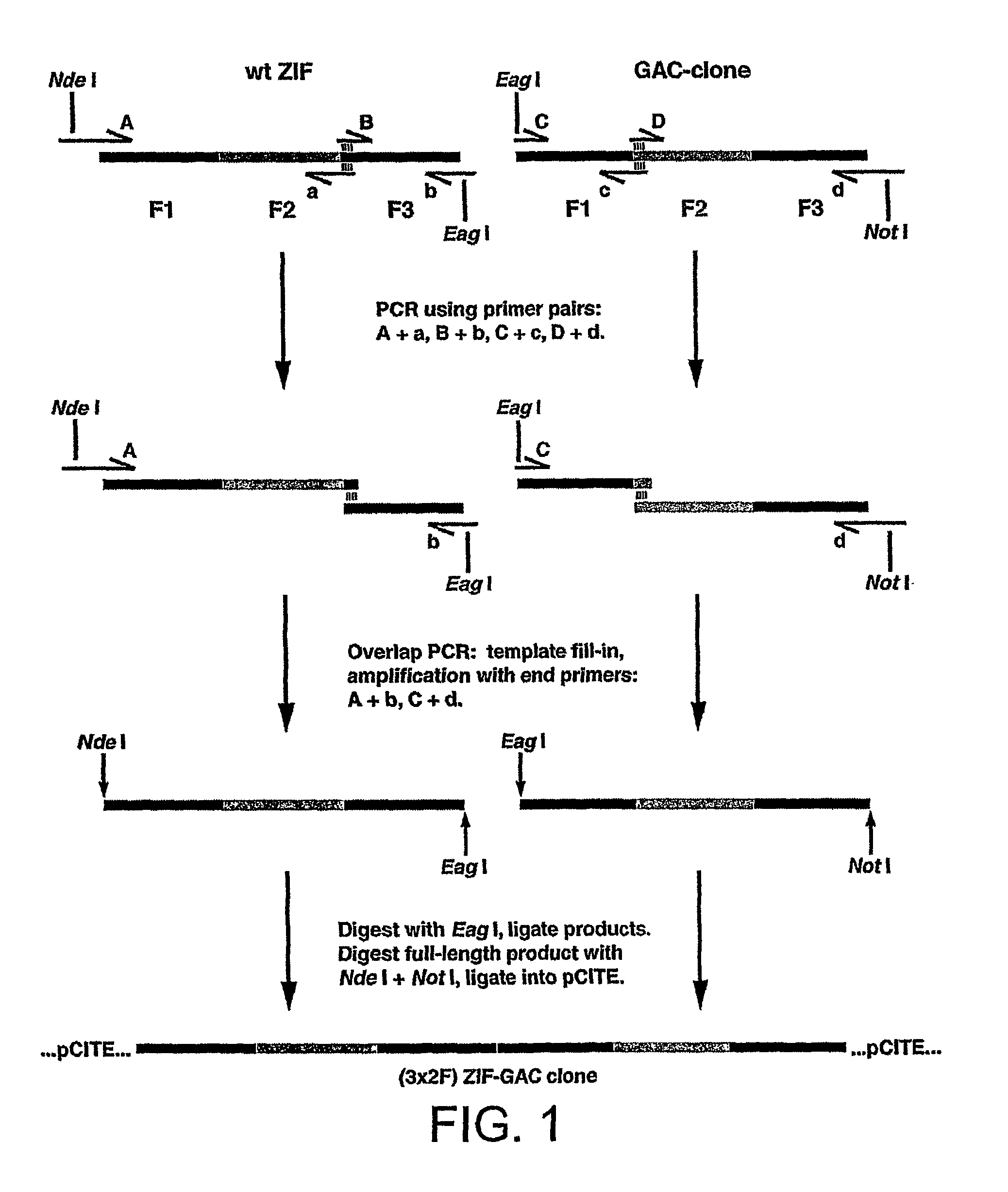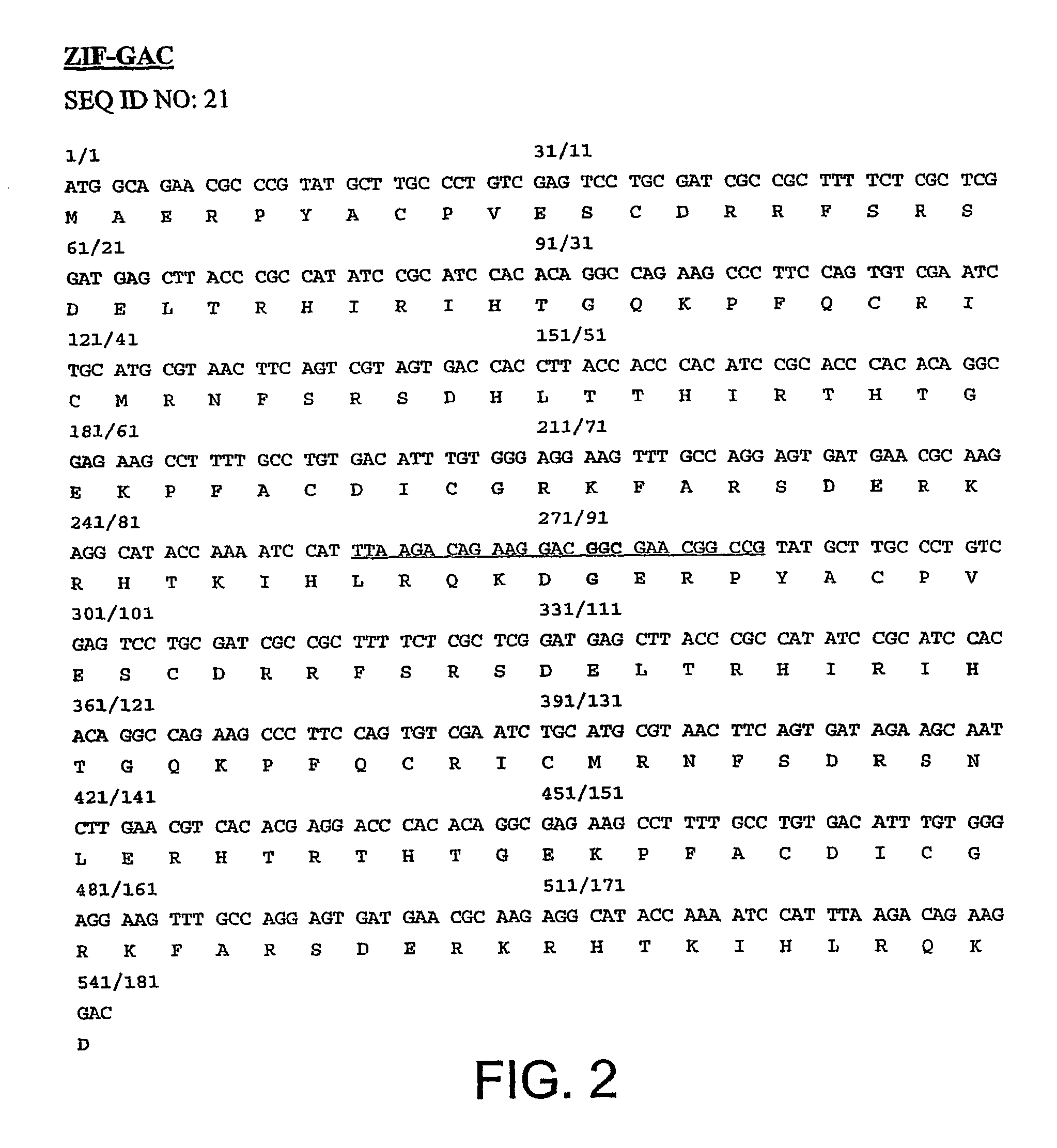Methods and compositions for linking binding domains in nucleic acid binding proteins
a nucleic acid binding and domain technology, applied in the field of methods and compositions for linking binding domains in nucleic acid binding proteins, can solve the problems of difficult or impossible to design zinc fingers which bind specifically to that sequence, pyrimidine-rich dna sequences comprise less favorable binding sites for zinc fingers, and current methods for the design and selection of zinc finger modules are not generally capable of producing zinc finger proteins
- Summary
- Abstract
- Description
- Claims
- Application Information
AI Technical Summary
Benefits of technology
Problems solved by technology
Method used
Image
Examples
example 1
Constructs, Targets and Nomenclature
[0208]In order to combine the benefits of tight binding to an extended DNA sequence, coupled with the flexibility to skip bases in the DNA target site, we designed a series of six fingered chimeric zinc finger proteins derived from wild type ZIF fused to a GAC-clone. Each construct comprises three pairs of zinc fingers separated by extended, flexible linker peptides. These are termed “3x2F peptides”.
[0209]One such flexible linker construct comprises the fingers of the wt ZIF and GAC with zinc finger pairs separated by -GGE / QKP- (SEQ ID NO:60 or 61) and is termed 3x2F ZGS (FIG. 3). This peptide targets the contiguous DNA binding sequence, bsC (Table 1), which comprises the wt ZIF and GAC-clone binding sites. To allow some variation in the binding sites targeted by the 3x2F protein, finger pairs are also separated by -GGSGE / QKP- (SEQ ID NO:62 or 63), or -GGSGGSGE / QKP- (SEQ ID NO:64 or 65) linker sequences to create the 3x2F ZGL and 3x2F ZGXL constru...
example 2
Construction of 3x2F ZGS Zinc Finger Construct
[0212]The 3x2F ZGS zinc finger construct is created by linking the third finger of wild-type ZIF to the first finger of the GAC-clone using the peptide sequence GERP. To divide the new peptides into three pairs of fingers, one glycine residue is inserted into the peptide linker between fingers 2 and 3 of wild type ZIF and between fingers 1 and 2 of the GAC-clone. The amino acid and nucleotide sequences of the 3x2F ZGS construct are shown in FIG. 3.
[0213]The construction of 3x2F ZGS is described with reference to FIGS. 1 and 3. As shown in FIG. 1, the 3x2F ZGS construct is made by mutagenic PCR of wild type ZIF and GAC-clone templates. ZIF and GAC-clone templates are as described in Choo &Klug (1994), Proc. Natl. Acad. Sci USA 91, 11163-11167. Four pairs of oligonucleotide primers, A+a, B+b, C+c and D+d are used. As indicated in FIG. 1, primers A, a, B and b are used to amplify and mutagenise wild type ZIF sequence, while primers C, c, D ...
example 3
Construction of the ZIF-GAC Fusion Construct
[0217]The control construct ZIF-GAC is created by joining the third finger of ZIF to the first finger of the GAC-clone using the peptide sequence described by Kim and Pabo (1998, Proc. Natl. Acad. Sci. USA 95, 2812-2817), -LRQKDGERP- (SEQ ID NO:66). This linker is designed to have compatible ends with the adjacent zinc finger sequences. A modification of the method as described above for Example 2 is used. Thus, primers A and b (primer b having the sequence shown below) is used to amplify wild type ZIF, while primers C and d are used to amplify the GAC clone, and the two amplified sequences joined together. The amino acid and nucleotide sequence of the ZIF-GAC fusion construct is shown in FIG. 2. The oligonucleotide primer sequences A, C and d as shown in Example 2 are used for constructing ZIF-GAC, except that primer b has the following sequence:
[0218]
Primer b: Eag I Gly5′ GCA AGC ATA CGG CCG TTC GCC GTC CTT CTG TCT TA...
PUM
| Property | Measurement | Unit |
|---|---|---|
| volume | aaaaa | aaaaa |
| volume | aaaaa | aaaaa |
| pH | aaaaa | aaaaa |
Abstract
Description
Claims
Application Information
 Login to View More
Login to View More - R&D
- Intellectual Property
- Life Sciences
- Materials
- Tech Scout
- Unparalleled Data Quality
- Higher Quality Content
- 60% Fewer Hallucinations
Browse by: Latest US Patents, China's latest patents, Technical Efficacy Thesaurus, Application Domain, Technology Topic, Popular Technical Reports.
© 2025 PatSnap. All rights reserved.Legal|Privacy policy|Modern Slavery Act Transparency Statement|Sitemap|About US| Contact US: help@patsnap.com



